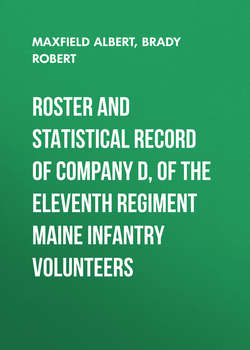Roster and Statistical Record of Company D, of the Eleventh Regiment Maine Infantry Volunteers

Реклама. ООО «ЛитРес», ИНН: 7719571260.
Оглавление
Maxfield Albert. Roster and Statistical Record of Company D, of the Eleventh Regiment Maine Infantry Volunteers
AUGUSTA AND WASHINGTON
THE PENINSULA CAMPAIGN
HARRISON'S LANDING
YORKTOWN
MATTHEWS COUNTY
GLOUCESTER COURT HOUSE
THE DEPARTMENT OF THE SOUTH
FERNANDINA, FLORIDA
MORRIS ISLAND
THE CAMPAIGN OF 1864
BERMUDA HUNDRED
DEEP BOTTOM
BEFORE PETERSBURGH
THE NORTH SIDE OF THE JAMES
CHAPIN'S FARM
THE FALL OF PETERSBURGH
THE PURSUIT AND THE SURRENDER
AFTER THE SURRENDER
Personal Sketches
Отрывок из книги
This Company was formed in the early Fall of 1861. Its members were chiefly from the towns of the upper Penobscot, from Lee, Springfield, Topsfield, Enfield, Prentiss, and contiguous towns; a few from other parts of the State signing the Company rolls at Augusta.
According to its first descriptive list, much the greater number of the original members of D were farmers by occupation at the time of their enlistment, and most of them were young men of from eighteen to twenty-four years of age. And according to the same authority, its voluntary organization consisted of Leonard S. Harvey, Captain; John D. Stanwood, First Lieutenant; Gibson S. Budge, Second Lieutenant; Robert Brady, First Sergeant; with Abner F. Bassett, Jas. W. Noyes, Judson L. Young and Francis M. Johnson as Sergeants; John McDonald, Richard W. Dawe, Ephraim Francis, Hughey G. Rideout, John Sherman, Benjamin Gould, Wm. H. Chamberlain and Freeman R. Dakin as Corporals; Robert A. Strickland, Musician; Henry W. Rider, Wagoner; the rest of the Company, 77 in number, consenting to serve their country as private soldiers.
.....
The supply trains had been left behind in leaving the lines before Yorktown, and when enterprising wagon-masters did get their trains towards the front, they were compelled to give way to hurrying troops and artillery. It now became necessary to await the coming of these but lately despised supply trains, for soldiers, to march and fight, must be fed, and you might as well try to get fight out of empty cartridge boxes as out of empty haversacks.
A few days then, we of necessity spent before Williamsburg, to rest the exhausted troops and to replenish empty cartridge boxes and haversacks. These few days were mainly passed by our men in taking a first sight of the horrors of war. Not only our own wounded were there, but the enemy's as well, left behind in the care of their surgeons, in the hurried flight of the rear guard that had made the stand for delay at Williamsburg. Cut, hacked, shot, dead and dying, a sorry sight there was in the barracks Confederate troops had occupied during the winter, now used for hospital purposes. And out on the field was a worse one. Dead bodies lay where they fell, and as they fell. Some in the act of loading, some as if firing, these that had been shot dead in their tracks; others lay on their backs or curled into tortuous shapes, staring stonily, as if for a last look at the world that had faded from their darkening eyes as the life blood poured from their mortal wounds. However hardened we became afterwards, the most indifferent of us by nature was then visibly affected by the gruesome sights we saw on the bloody field of Williamsburg.
.....